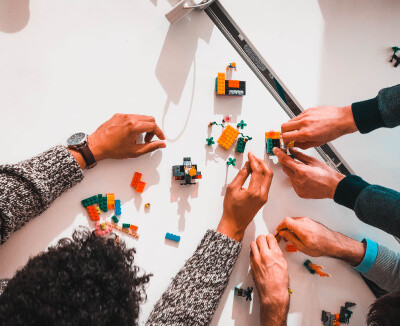Content
Amazing fact: the global art trade is estimated at $65 billion, of which $11.8 billion, or 23% of sales, are accounted for by online platforms, marketplaces, etc.
- Since 2019, namely due to the COVID-19 pandemic, the market has begun to transform, offering traditional customers non-traditional methods of valuation (new technology in art) and interaction with works of art.
Today, we can observe the consequences of the digitalization of the industry and its adaptation to the new requirements of art lovers.
Yes, we are talking about traditional art, and artists’ paintings digitized to the smallest detail. Today, you will learn how digital technologies in design art practice, platforms, and solutions can bring this market to a new level and increase its profitability.
A Brief Overview of the Role of Digital Technology In Contemporary Art
Digital technology in art and design is effectively revolutionizing the industry, offering new opportunities for both artists and art lovers. Here are some of the key points of digitalization:
- New platforms and techniques:
- Digital painting. Artists use software such as Adobe Photoshop and Procreate to create artwork that can mimic traditional painting or generate new styles.
- 3D modeling and animation. Tools like Blender and Maya help artists to create complex 3D sculptures and animations, scenes, and videos.
- Virtual reality (VR) and augmented reality (AR). These technologies provide innovative experiences that allow viewers to interact directly with art.
- Accessibility and distribution:
- Online platforms. Artists can publicize their projects on social media and art platforms, thus reaching a much larger audience than traditional exhibitions.
- Digital prints and NFTs. New opportunities for monetizing digital art with sophisticated algorithms for protecting the originality of works, proof of ownership, and identification.
- Interactive art:
- Participation of viewers. Digital technologies allow the creation of interactive installations where viewers can influence the work of art, for example, add to or modify it in individual copies, etc.
- Collaboration and community:
- Global collaboration. Artists can collaborate with each other using digital tools. As a result, collaborative works of art are created that are not subject to time and distance.
- Online communities. Digital platforms open up a space for collaboration where artists can share ideas, techniques, and feedback.
- Conservation and restoration:
- Digital archiving. Museums and galleries use digital technologies to digitize and digitize works of art, guaranteeing that they remain accessible to future generations.
- Restoration methods. Highly sophisticated image generation technologies help to enhance the resolution of images, and restore and analyze works of art, revealing details that may have been lost over time.
Thus, the influence of art technologies is critical both for the new generation of artists and for the long-term preservation of classical works, booming methods of dealing with paintings, etc.
Tools and Technologies In Art
An eye-opening fact is that digital animation technology in art can animate paintings and turn them into looping animated videos. Rowling described something similar in the Harry Potter series, but there it was magic, while in the real world, it is science and technology.
In addition to animating the Mona Lisa, which can now wink at you from the screens, technology in art offers other, not quite standard, methods of interaction with paintings, both new and digitized.
Let’s take a closer look at some of the most amazing technologies and tools for collaborating with artworks.
Virtual and Augmented Reality
Digital art tech, and especially AR/VR, can expand the horizons of art lovers.
Imagine that instead of just taking a look at a painting, a conventional landscape, you can literally move into it.
For example, walk along a dirt road, contemplating the glare of the sun in the neighboring pond and watching the rye ears sway under the gentle breeze.
A more traditional experience is a virtual visit to a museum, with a simulated walk through the hall and viewing 100% copies of artworks from different angles.
Blockchain and NFTs
Technology for art, in particular NFTs, allows you to enjoy digitized works of art, own the rights to them, and even monetize paintings.
Art and tech are now quite closely linked, so they provide additional opportunities for rights holders.
For example, by owning a digital painting, you can monetize this work by providing paid access to it or even selling a copy at auction, literally like a physical painting.
By the way, on some marketplaces, the value of NFTs with artworks can reach millions of dollars, and we are not even talking about classical paintings but about quite modern images, including generated ones.
AI Art Evaluation
Digital art platforms such as one of the latest developments by AdvantISS can become valuable assistants for art lovers and experts.
For example, they can be used to scan paintings, make 100% 3D copies with brushstroke texture, canvas irregularities, frame deformation, etc. Identity is the main characteristic of digitized artworks.
Further, on the basis of the same or external platforms, you can organize full-fledged auctions and sell originals with copies as well as on offline platforms using traditional methods.
Interactive Art
Digital art and technology are actually giving rise to completely new and innovative methods of user interaction with works of art and their authors (contemporary artists). For example, it is now possible to collectively discuss paintings or even edit them in separate instances.
Moreover, with the help of new technologies, art lovers can even communicate with avatars of classics, such as Van Gogh, and ask them about the peculiarities of their works. In particular, they can find out about the reasons for the appearance of paintings, details depicted on the canvases, etc.
Yes, the latter is more of an entertainment aspect, as the AI controlling the avatar is not the real personality of the artist, but it demonstrates the actual role of technology in art, both modern and canonical.
New art tech can actually offer both creators and connoisseurs quite a few innovative opportunities, such as walking through paintings via VR, interactivity in 2D, etc.
Predictive Analytics for Art Auctions
Digital art tech is not just about expanding the visual possibilities of working with art through the digital space. With the help of modern technologies, including artificial intelligence, it is possible to predict the demand for paintings, sales, etc.
The same is true for other performance indicators of various thematic platforms. In particular, these systems allow you to plan work, engage artists, accumulate artworks, sell them, rent them out, proactively assess the effectiveness of these actions, minimize risks, etc.
Management Systems
Specialized management systems also tie into technology in art. A striking example is a recent project by AdvantISS. This particular kind of platform can be thought of as a digital library of artworks designed to store and manage content.
For example, with the right system, you can keep track of the digital works available, their value, number of copies, and active auctions.
An additional feature is the blockchain and NFT component, which allows you to protect conditional content from plagiarism, track its distribution, etc.
Conclusion
The impact of digital technology is increasingly felt every day, including in the art segment. Currently, users already have interesting tools and systems for interacting with paintings, creating new and modern content, sharing it, and monetizing it.
With the exponential growth of technology, more and more bold and innovative solutions will appear in the digital space, part of which will be the platforms released by AdvantISS.
Don’t hesitate to contact us if you have a vision and want to deliver it to life!




